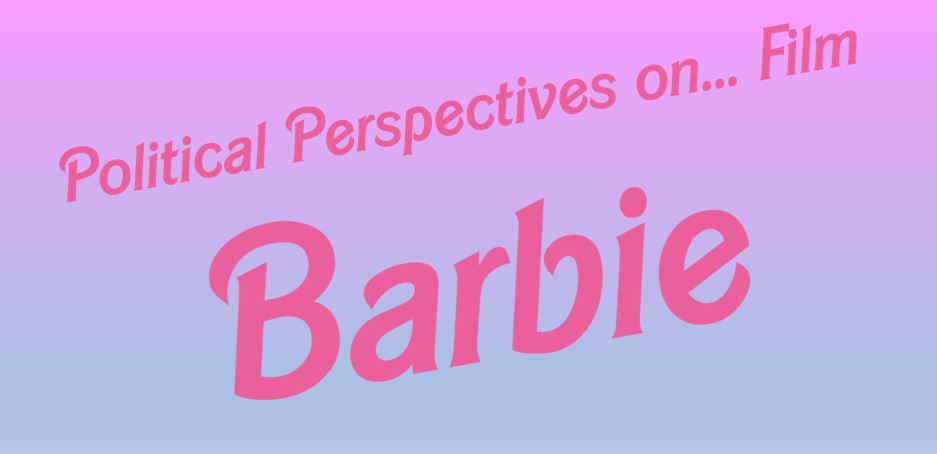
Barbie: A Critical Commentary
Baishali Chatterjee and Amita Pitre are two feminists, deeply engaged in the social sector, working on gender equality. They recently hosted a two-part podcast on ‘Gender and the City’ which has been well received. The authors declare no conflict of interest and have not received any financial assistance for this piece of writing. This post was originally published on Medium.
Barbie, a pink spectacle?
We watched Barbie in a movie hall in South Bombay in the second week after its release. The hall was full of teenagers and college students (more girls than boys but yes, also a bunch of boys dressed in pink), parents with their young children (perhaps they thought this was a movie of the likes of The Lego Movie?), and then people like us, in the absolute minority – mostly adult women and a few good men. The young girls had really made an effort to be dressed in various shades of pink (Warner Brothers claims to have launched a pink movement and apparently the world ran out of the colour pink). Despite the fact that it is now the biggest hit film to be ever directed by a woman filmmaker, there were things about the movie that continued to bother us, and this article is our attempt to name them.
Before watching the movie, the only reference point either of us had was the monologue by America Ferrera which just into the first week of the film’s release, seemed to have captured the American feminist imagination and was all over social media:
“It is literally impossible to be a woman…. You have to be thin, but not too thin. And you can never say you want to be thin. You have to say you want to be healthy, but also you have to be thin. … I’m just so tired of watching myself and every single other woman tie herself into knots so that people will like us.”
The monologue is hilarious, highly entertaining, deeply resonating, a master stroke at scripting, whilst also thought-provoking. But ironically, for us, this was also the time the film came closest to capturing some version of a feminist angst (despite the debates over it representing a highly individualised liberal American rant – which we will explore further, later).
Barbie is an ingenious and clever attempt at using a much critiqued cultural symbolism and turning it on its head to make deeper arguments about the current nature of patriarchy in a post-Trump world, notwithstanding ads that would have us believe that indeed ‘we have come a long way, Baby!’ (from the 1968 world of Virginia Slims). While we loved Gerwig’s Little Women (which remained true to its feminist roots), Barbie ultimately falls prey to its own visions of grandeur and ends as a feeble and superficial attempt by white feminism to tell us what’s wrong with America today (not enough women on the board of corporate America, street sexual harassment, lack of women’s representation in political leadership and the judiciary among others).
It delivers this message while glorifying an individualistic women’s liberation steeped in a glossy, opulent, uncaring capitalist patriarchy, possible only for a few. The film’s answer to women’s woes appears to be, ‘Move over Patriarchy, here comes Matriarchy’, with all other factors remaining the same. This seemed to us more of ‘lean in’ school of feminism, which while offering visions of a feminist solidarity, remains limited and rooted in its own smorgasbord of elitism.
Barbie: A historical context
The beginning of the movie traces the origins of the doll and puts a feminist spin onto it by positing it as doll that finally broke the boundaries between the home and the outside world for American girls (because our first dolls in our girlhood days were baby dolls that we fondly bathed and brushed and put to sleep). However, interestingly enough Barbie’s physical appearance was modelled on the German Bild Lilli doll, a risqué gag gift for men based upon a cartoon character featured in the West German newspaper Bild Zeitung. To some extent, Barbie is credited with introducing a role model to the restricted childhood of American girls of the 1950s by creating an option for a woman who existed as an individual (had no male partner or children). In fact, Mattel did withstand the pressure to create Barbie’s babies by creating Barbie baby-sitting playsets. The first black doll, ‘Christie’ came out as a franchise doll (not Barbie) in 1968, in the midst of the civil rights movement when Mattel was critiqued for not representing diversity. However, it wasn’t until 1980 that Barbie had its first African American incarnation. Barbie’s fashionista line around 2014 had a range of body colours and shapes and was in response to falling profit margins and new age parents asserting against impossible body standards and stereotypes for their girls. In a clever move, Gerwig takes away the sting of what could have been its sharpest criticism, that of focusing only on a stereotypical form of blond beauty while neglecting all other forms, by naming the protagonist ‘stereotypical Barbie’.
Barbieland: The feminist dream come true?
The film takes us into a re-imagined Barbieland which is the matriarchal utopia that will have feminists salivating, Gerwig seems to imply. It is a land by, for and of women. The President is a black woman, the courts are made up of only women judges and all legislators are women. Men are at best ‘Cheerleaders, surfers, and accessories for Barbies.’ Ken, who aspires to be Barbie’s boyfriend, laments that he is always number two. Ken is either ignored, shooed-off, discounted, made irrelevant or at best accommodated and banished into a forced Ken–dom (until the end of the movie where Ken learns that he’s Kenough). Barbieland simply replaces one hierarchy with another. If Gerwig’s intention was to mirror women’s exclusion in the real world, then this comes off as a mere caricature.
The criticism of Barbie having set impossible body standards for young girls which is alluded to in the initial part of the film (one of the reasons why she is made to feel unwelcome in the real human world by a Gen Z teenager) is never explored through the film to any kind of logical conclusion. By casting Robbie Margot, was Gerwig trying to highlight that if the world hasn’t changed for stereotypical beauty, it is even less likely to have progressed for the other women? The argument seems hollow. Barbie develops thoughts of death, flat feet and cellulite, but continues to epitomise a stereotypical beauty. Even the teenager who criticises her in the beginning for strengthening body-shaming attitudes, then not only roots for her, but also actively helps her to make the journey back to the human world. The movie also leaves us unconvinced that Barbie would want to continue in the flawed, human world when so much is going for her in Barbieland. Is that the idea, making a sequel?
Barbieland is supposedly the dream-come-true for diversity, but hardly any characters other than Margot, are etched out enough or have a voice for the audience to remember. The black, brown, fat, short, gay, queer Barbies are all in the background. But them just being there making up the backdrop is having your cake and eating it too.
The vagina dilemma
The vagina (or the lack of it) draws your attention in two places in the movie. Once when Barbie encounters street sexual harassment in the human world, she shouts out that she doesn’t even have a vagina. And then when she is finally a part of the human world, one of the first things she does is to go to a gynaecologist! The visit is left vague and up to your imagination. Is she there because she wants to grow a vagina? Is she considering a pregnancy? Or does she want to experience vaginal sexual pleasure?
The feminists would agree that women’s vaginas have played a central role in their subordination, right from controlling their sexual behaviours, their wombs and sexual violence. Is the lack of a vagina what makes Barbieland even possible?
Patriarchy and capitalism
Ken’s discovery of ‘patriarchy’ in the movie does name the enemy that is forever on the verge of becoming the villain who must not be named, and to Barbie’s credit, the movie normalises it to an extent. You will relate to this, if, as a feminist, you have struggled to talk about it without naming it as Priyamvada Gopal puts it in her Al Jazeera article – dare to go ‘beyond the confines of the academia’ (or in our case, beyond the confines of feminist circles). However, it becomes a favourite term to be bandied around in the movie and rarely alludes to the structural foundations of patriarchy. What keeps the patriarchy well fuelled? And what role has Barbie herself played in upholding the structure? And importantly, are these the same processes that would keep a matriarchy going strong as well?
All the Barbies have lovely homes, the best designed clothes, beautiful sandals, plenty of leisure time, and everything you could wish for. The Barbie utopia exists without any of the care work that is a major occupation of women’s lives globally. As long as you are in Barbie utopia, the messiness of what creates this wealth and lifestyle, who profits from whose labour, not to say women’s unpaid and underpaid labour which keeps the society going, is conveniently glossed over.
Barbie seems to embody an individualised white liberal privileged woman’s feminism. While this feminism seeks gender equality, it is often shorn of the intersectionalities of race, sexuality, gender identity, caste, class, ethnicity which create further marginalisations. Gerwig has been credited with taking pot-shots at capitalism, ridiculing even the production company, Mattel itself, and getting away with it. For example, Barbie responds to the criticism of being a fascist by saying that she doesn’t have ‘control of commerce or the railways’, trying to point to the connections between fascism and big capital. While there is some self-reflexivity in mentions of a ‘white saviour complex’, these barely register and seem an inconsequential attempt to set the politics right.
That this Mattel production is a careful strategy to re-brand and market Barbies is a no-brainer. While we ponder the fascist, feminist or consumerist leanings of Barbie, or indeed how difficult it is to be a woman filmmaker in Hollywood, Mattel are laughing all the way to the bank. Women’s liberation, anyone, to boost your markets? So who does pop up feminism serve?
Interestingly, coming to real life, the Barbie dolls themselves, have never been manufactured in the USA. Instead they are manufactured in factories in Asia-China, Indonesia and Malaysia. Who are the women who make Barbies (assuming that they are women based on prevailing data of how most of American goods are created in factories down south with overwhelmingly female labour)? If they lived in Barbieland, who would make the Barbies?
A feminist utopia
What the film captures accurately is that Kens love to ‘do patriarchy’ once they realise the gains from it for men, however illusionary they may be. When Barbieland women realise this, towards the end of the movie, they want to rebel and go back to the ‘good old times’. Where women are presidents, everyone has a good life, there is some space for diversity and Kens are inconsequential. Now does that smack of a competition between genders, with the messy systemic issues remaining the same?
Conclusion
Women’s liberation as envisioned in Barbie, unlike the vision given by southern feminists, does not go the whole distance to analyse or remedy the root causes of women’s subordination, ignoring the historical reality of a colonial, capitalist, exclusionary, cis-hetero-patriarchal society which only strengthens women’s subordination, and also marginalises men at times. Barbie is a lost opportunity on what could have been a meaningful commentary on the current politics of women’s rights and gender equality. It remains a mirage of what could have been a truly clever exposure and subversion of patriarchy rooted in the various systems of power. Instead, it becomes a superficial and somewhat unconvincing account of why the real world, despite its flaws of sexism and patriarchy, still attracts Barbie. And how women’s true liberation lies in adopting a men-excluding matriarchy which fortunately or unfortunately, depending on your position, is possible only in Barbieland.
Bios
Amita is a feminist and has worked on gender equality for the last 20 years. She is a Fulbright Nehru scholar in Women’s Studies and has a masters in Public Health. She has worked with leading development organisations such as Oxfam, UNFPA and TISS. Currently she works with the ‘Strategy and Feminist Futures Team’ at Oxfam International. Here she is involved with better recognition, remuneration and representation for Care Work as a central aspect of the Society and Economy. She has also undertaken extensive policy research, advocacy and writing on gender based violence and gender and health.
 Baishali Chatterjee is an intersectional feminist practitioner and a gender justice expert with 20 years of experience in global development working as a grant manager, policy and program specialist on gender equality and women’s rights. She has multifunctional experience in leading international development agencies such as Action Aid, Christian Aid, Oxfam and IPPF, covering a wide spectrum of issues with special thematic focus on violence against women, women’s economic justice, climate and gender justice, and programming through a gender transformative approach. She currently works with Christian Aid, as its global thematic lead on Gender Justice.
Baishali Chatterjee is an intersectional feminist practitioner and a gender justice expert with 20 years of experience in global development working as a grant manager, policy and program specialist on gender equality and women’s rights. She has multifunctional experience in leading international development agencies such as Action Aid, Christian Aid, Oxfam and IPPF, covering a wide spectrum of issues with special thematic focus on violence against women, women’s economic justice, climate and gender justice, and programming through a gender transformative approach. She currently works with Christian Aid, as its global thematic lead on Gender Justice.


0 Comments